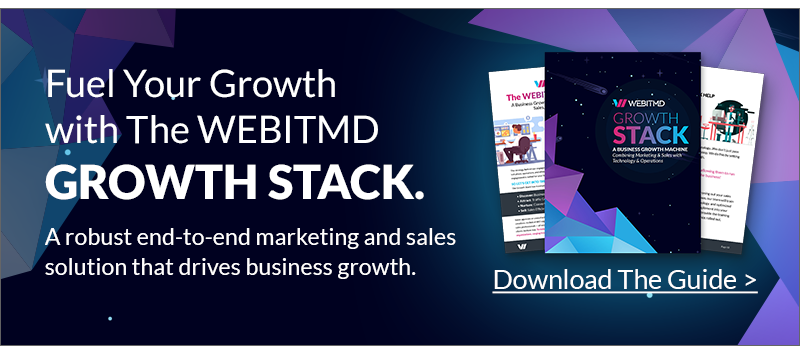If you have been keeping up with the latest buzz in digital marketing blogs, webinars, and social media groups, you have likely come across the terms “growth marketing” and “marketing stacks”.
The world of marketing is evolving. Although most agencies are still stuck in the rinse and repeat world of SEO and PPC services that garner little results, some have elevated to true growth-driven agencies engineering measurable, customized stacks. One way to get insight into how marketing is changing is to compare today’s marketing software providers, to the numbers that existed in our recent past. According to ChiefMarTech, marketing technology solutions have more than doubled since 2016. This shows that businesses are waking up to their need for best point solutions available to addressing specific marketing challenges, and savvy marketers understand that business growth stacks are the future.
What is a Growth Marketing Stack?
A growth marketing stack is a set of tools and strategies designed to help organizations maximize their ability to hit revenue targets while achieving year-over-year growth. Today’s best growth marketing agencies create stacks composing of technologies and strategies; they are based on a deep understanding of how a brand’s customers consume information and how purchasing decisions are made.
How do Marketing Stacks Work?
In order for growth marketing stacks to work well, they must be goal-focused. This means the client needs to understand what it takes to achieve growth goals from his internal side, and how his marketing agency can help him become and remain successful. This is achieved through a partnership built on trust and mutual goal alignment. It also requires streamlining the marketing stack for prime efficiency, driving traffic from all available pockets, have data streams, and know how to synch multiple strategies to achieve the same goals while generating measurable reporting and continuous optimization.
Having an advanced understanding of your buyers is the rocket fuel to give marketing stacks their momentum. If you aren’t capable of advanced audience targeting, then your messaging will be sent to deaf ears. By creating buyer personas and mapping out the three stages of the buyer’s journey, you can target the right audience segments with a custom strategy designed to convert leads, and increase sales.
Driving Traffic Requires a Multichannel Approach
Driving traffic is an art and a science. It is also your biggest opportunity for getting new leads. In order to get as many sets of eyes as possible on your content, you need to drive web traffic through a targeted multichannel approach. This will combine the following:
- Organic search
- Paid media
- Social media marketing
- Editorial outreach
Some segments of your audience will call for a custom traffic generation strategy that may focus more heavily on one (or a few) of these over others. A robust growth marketing stack will leave no stone unturned at the top of the funnel. This means every opportunity to drive traffic to your website will be made, using every channel as appropriate.
We already talked about how a successful growth stack runs on how understanding your buyers. In terms of driving traffic, marketers need to create top-of-funnel content attracting the modern buyer. Today’s consumers don’t rely on salespeople for information required to make purchasing decisions. Five years ago it was common to see landing pages receiving traffic from SEO and PPC in which shoppers would fill out a form and then get contacted by a sales team for more information. Virtually nobody goes through this process to make a purchase. Today’s buyers are savvy and spend loads of time researching products. Driving traffic means you need to attract people by getting the attention of your prospects. Before someone is ready to buy (or even before they know what product they need to resolve their pain point) you can target people with custom content that educates them through the buyer’s journey. So what happens after a lead enters the system from multichannel traffic generation? Once someone becomes a lead they will be scored and nurtured through email marketing campaigns.
Growth Hacking with Data Streams
Utilizing data to growth hack your way to goal completions is a core component to any marketing stack’s objectives. But today’s growth-driven agency’s don’t just base their client’s strategies around Google Analytics. Marketing automation platforms and CRMs like HubSpot have customized data fields that go way beyond the opaque insights offered by GA. Rather that seeing how many “new users” your landing page received you can get personal information on people such as their name, job role, industry, and even the names of social groups they regularly engage. This will allow you to further segment leads and send them custom content that targets their unique needs.
The best growth marketing stacks also create data streams that feed from social media platforms to in order to get detailed insights into your buyers. This allows marketers to see which topics get liked and shared the most, and unique pain points are often expressed in comments. You can even use social listening software to make data collection easy, and to monitor monthly trends.
Growth Marketing Stacks Synch, Nurture and Automate
Your digital growth marketing agency will determine specific strategies and pieces of technology to generate leads, nurture them, and enable sales. In order for a marketing stack to fire efficiently and serve its purpose, all components must be aligned. This means paid media, SEO, social media marketing, email marketing, inbound and blogging (just to name a few) must be goal-focused and set to run as one hybrid brain. Marketing automation will ensure the right messaging reaches the right buyer groups, at the best possible times. Social listening and data will help marketers optimize the working parts to ensure maximum reach and nurturing capabilities.
The best CRMs for growth marketing have automation tools. Whereas traditional email marketing blasts content to one big list, any email marketing within a growth stack requires precise audience targeting through data-backed list segmentation. There is also a science and an art to nurturing these leads until they are informed enough to make a purchasing decision. This is what a growth marketing stack does best; driving top of funnel traffic into the system, converting them into leads, and taking them down a detailed buyer’s journey until they become delighted customers.
Are You a Fit for Business Growth Marketing Stacks?
If your sales cycle makes sense for a marketing stacks, you are a good fit because no matter how successful you may be at turning a profit, growth stacks drive even better results with precise targeting and nurturing capabilities. You are an even better fit if you have a history of letting leads slip through the cracks, or you flat out have a problem in generating leads. Marketing stacks have a number of moving parts and ultimately, it needs to make sense for your business and your goals. That said, it is wise to contact a number of digital marketing agencies that offer growth stacks, and vet your potential fit with each one before making a final decision.
Did this Article Offer Value in Understanding Growth Marketing Stacks?
If you found value in this content, we invite you to dive even deeper by downloading our FREE comprehensive guide on growth marketing stacks. Give the guide a read, see if it seems to make sense for your business growth needs, and give us a call. We would love to learn about your operation, current marketing, and set you on a path to hit your high revenue goals!










.jpg)



.jpg)





![5 Reports to Elevate Your HubSpot Sales Dashboard [+ Examples]](https://blog.webitmd.com/hs-fs/hubfs/Imported_Blog_Media/6-winning-examples-of-a-hubspot-sales-dashboard-2.png?width=767&name=6-winning-examples-of-a-hubspot-sales-dashboard-2.png)